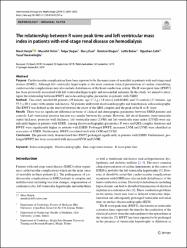The relationship between R wave peak time and left ventricular mass index in patients with end-stage renal disease on hemodialysis

View/
Date
2019Author
Kalçık, MacitYetim, Mücahit
Doğan, Tolga
Eser, Barış
Doğan, İbrahim
Bekar, Lütfü
Karavelioğlu, Yusuf
Metadata
Show full item recordAbstract
Purpose Cardiovascular complications have been reported to be the main cause of mortality in patients with end-stage renal disease (ESRD). Although left ventricular hypertrophy is the most common clinical presentation of cardiac remodeling, cardiovascular complications may also include disturbances of the heart conduction system. The R wave peak time (RWPT) has been previously associated with left ventricular hypertrophy and myocardial ischemia. In this study, we aimed to investigate the relationship between RWPT and echocardiographic parameters in patients with ESRD. Methods This study enrolled 66 patients (29 females, age 57.2 +/- 12.8 years) with ESRD, and 72 controls (37 females, age 55.3 +/- 10.1 years) with similar risk factors. All patients underwent electrocardiography and transthoracic echocardiography. The RWPT was defined as the interval between the onset of the QRS complex and the peak of the R or R' wave. Results There was no significant difference in terms of clinical and demographic parameters between ESRD patients and controls. Left ventricular ejection fraction was similar between the groups. However, left atrial diameter, interventricular septal thickness, posterior wall thickness, left ventricular mass (LVM) and left ventricular mass index (LVMI) were significantly higher in patients with ESRD. Among electrocardiographic parameters, P wave and QRS complex durations and RWPT were significantly higher in patients with ESRD. Prolonged RWPT, increased LVM and LVMI were identified as associates of ESRD. Furthermore, RWPT correlated well with LVM and LVMI. Conclusion The present study demonstrated that RWPT prolonged significantly in patients with ESRD. Furthermore, prolonged RWPT has been associated with increased LVM and LVMI.

















